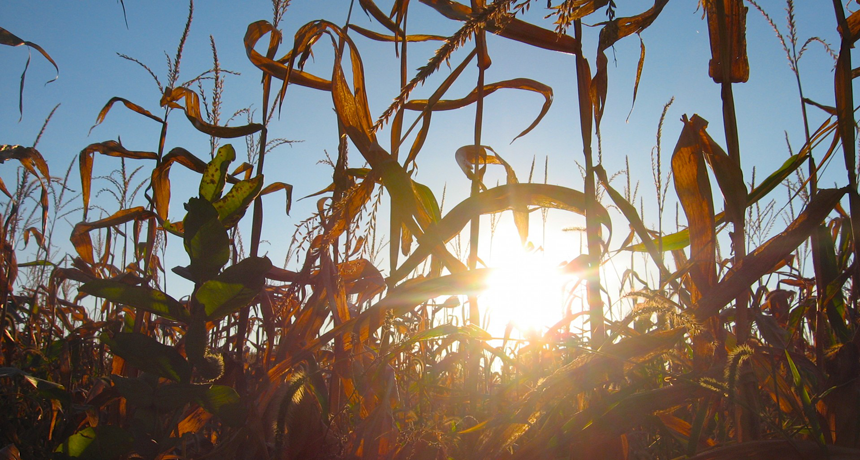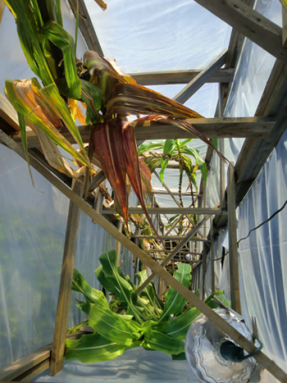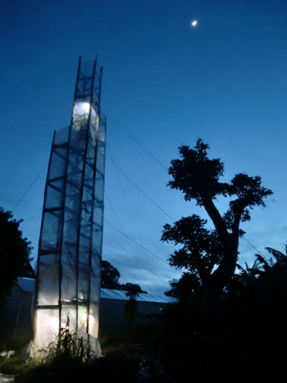World’s tallest corn towers nearly 14 meters
Science — and short nights — helped the stalks attain record heights

Typical corn stalks, like those shown here, grow to heights of 2.5 meters (8 feet). But with genetic tweaks and changes to how much light they get, some stalks can become true giants.
Ken Kistler / Public Domain
Western New York is getting its own kind of rural skyscraper: giant corn stalks. A researcher there in Allegany now reports growing corn nearly 14 meters (45 feet) high. That makes it about as tall as a four-story building. They appear to be the tallest corn plants ever recorded.
A corn stalk typically grows to about 2.5 meters (8 feet). One strain from Mexico is taller, sometimes 3.4 meters or more. But when the nights are short and the days are long, corn has more time to tap growth-fostering sunlight. Then it can grow even more, sometimes taller than 6 meters (20 feet). Raising it in a greenhouse can add another 3 meters. And tweaking a gene called Leafy1 can up its height yet another 3 meters. Put them together and such factors can cause this strain to ascend nearly 14 meters, notes Jason Karl. He is an agricultural scientist who helped turn some corn plants into such giants.

The Mexican name for corn is maize. That’s also the common term for this plant outside the United States. The unusually tall maize type is called Chiapas 234. Usually “people try to make maize shorter, not taller,” Karl notes. “So it is plainly funny even to consider adding Leafy1 to the tallest strain.”
Corn is the most widely grown food crop in the United States. Most scientists who study corn want to make it better for harvesting. So why would farmers prize shorter corn? Shorter stalks flower earlier in the season. That allows the ears of grain (containing the ymmy kernels that we eat) to mature sooner.
But Karl isn’t interested in corn that blooms quickly or is easy to harvest (because climbing an 12- to 14-meter ladder to pick their ears of corn would hardly be easy). Instead, he wants to know which genes and other factors, such as light, affect the stalk’s growth.
The Chiapas 234 strain was discovered in the 1940s in Mexico. Researchers stored seed from it in a freezer for nearly 30 years. Then, in a 1970 experiment, they grew up some of that seed in a greenhouse. To simulate summer nights, they gave the plants only short periods of darkness. The corn responded by growing more leafy segments, called internodes. Each internode is typically about 20 centimeters (8 inches) long. The corn that you might see on an American farm today has 15 to 20 internodes. The Chiapas 234 strain had 24. When grown with short nights, its stalks developed twice as many.
Karl read about the 1970s night-length study with Chiapas 234. He also knew about a mutation in the Leafy1 gene that could make maize taller. He decided to put them together. “The mutation makes common U.S. maize a good third taller. And I had seen synergy between mutations and the night-length reaction,” he says. And that, he recalls, was a “good omen for discovering new things via preposterously lofty maize.”
What the researchers did
For his experiment, Karl grew the Chiapas 234 in a greenhouse with artificially shortened nights. Materials in the greenhouse walls filtered out some types of light. This allowed more reddish — or longer wavelength — light to reach the plants. That red light increased the length of the internodes. This made the plant grow to nearly 11 meters (35 feet). Then, Karl bred the Leafy1 mutation into the stalks by controlling the pollen that landed on each plant. The result was a nearly 14-meter stalk with a whopping 90 internodes! That’s about five times as many as regular corn produces.

“The science done here makes lots of sense,” says Edward Buckler. He is a geneticist with the U.S. Department of Agriculture (USDA). He has a lab at Cornell University in Ithaca, N.Y. Buckler was not part of the new study but says Karl’s way of growing tall corn should make it grow nearly forever. “I have just never seen anyone try this in such a tall greenhouse,” he says.
Paul Scott also was not involved in the study. This USDA scientist studies the genetics of corn at Iowa State University in Ames. “Plant height is important because it is related to yield,” he says. “Bigger plants tend to produce more grain, but if they get too tall they tend to fall over.” He says the new work helps scientists better understand which genes and other factors affect corn growth.
The new giant corn stalks have trouble surpassing 12 meters (40 feet). That’s a result of the genetic mutation inserted into the corn, Karl says. He is now trying to tweak the corn’s genetics by inserting other mutations to see if this corrects the problem. If they do, Karl suspects he might be able to get even loftier corn.
Corn is incredibly diverse, Buckler notes. There are thousands of strains grown all over the world. This work can help scientists understand why plants may grow differently depending on their location (which would affect day length and light levels).







